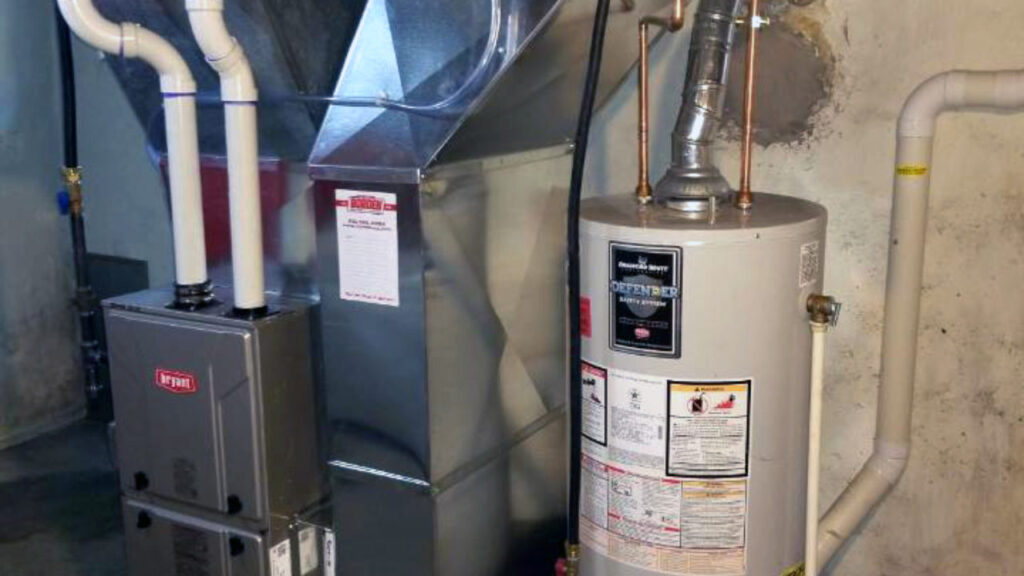Choosing where to put a furnace in a house is super important. You need to be able to get to it easily to fix it, so it’s usually in a basement, utility room, or garage. The furnace needs good airflow to work properly and to keep the area around it clear of stuff that can catch fire.
If you live in a place that floods, it’s important to put the furnace somewhere safe from water. It’s also important to think about how the hot air will get around your house. The furnace can make noise, so it’s better if it’s not near where you hang out a lot.
What Factors Determine the Ideal Location for a Furnace in a House?

The ideal location for a furnace in a house depends on several factors, including safety, efficiency, and practicality. Here are some key considerations:
Accessibility for maintenance and repairs
Ensuring the furnace is placed in an accessible location facilitates regular maintenance and timely repairs. Accessibility allows HVAC technicians to easily reach the furnace components, such as the burner, blower, and filters, for cleaning, inspection, and servicing.
This accessibility not only ensures the efficient operation of the furnace but also prolongs its lifespan by addressing potential issues promptly.
Adequate ventilation and airflow
Proper ventilation and airflow are crucial for the safe and efficient operation of a furnace. The location should allow for adequate airflow around the furnace to ensure proper combustion and ventilation of exhaust gasses.
Without sufficient ventilation, the furnace may not operate efficiently, leading to reduced heating performance, increased energy consumption, and potentially hazardous conditions such as carbon monoxide buildup.
Clearance from combustible materials
It’s essential to maintain adequate clearance around the furnace to minimize the risk of fire. Combustible materials such as paper, cardboard, and flammable liquids should be kept away from the furnace to prevent accidental ignition.
Clearing the area around the furnace also facilitates airflow, reducing the risk of overheating and fire hazards.
Protection from flooding
In flood-prone areas, it’s crucial to protect the furnace from water damage. Elevating the furnace or installing it on a platform can help prevent water from reaching critical components, such as the burner and electrical connections.
Additionally, installing a sump pump or other flood prevention measures in the basement can provide an added layer of protection for the furnace.
Efficiency of ductwork layout
The efficiency of the furnace’s ductwork layout can significantly impact heating performance and energy efficiency. The location of the furnace should allow for optimal ductwork design, minimizing bends, twists, and obstructions that can impede airflow.
Proper ductwork layout ensures even distribution of heated air throughout the house, maximizing comfort and reducing energy consumption.
Consideration of noise levels
While not always a primary concern, the noise generated by the furnace can affect comfort, especially if it’s located near frequently used living areas. Choosing a location away from bedrooms, living rooms, and other quiet spaces can help minimize noise disturbances.
Additionally, selecting a furnace model with noise-reducing features, such as insulated cabinets and variable-speed blowers, can further mitigate noise levels.
Compliance with local building codes and regulations
Adhering to local building codes and regulations is essential when determining the location of a furnace. Building codes may specify requirements regarding clearances, ventilation, and safety measures to ensure the proper installation and operation of the furnace.
Failure to comply with these regulations can result in fines, penalties, and potentially unsafe conditions for occupants. Consulting with HVAC professionals and local authorities can help ensure compliance with applicable codes and regulations.
FAQ’s
Should a furnace be in a bedroom?
No, it’s generally not recommended to have a furnace in a bedroom due to noise, safety, and ventilation concerns.
Can a furnace be in a closed room?
It’s not advisable to have a furnace in a fully closed room as it requires proper ventilation for combustion and safe operation.
Can a furnace be in the ceiling?
Furnaces are typically installed in basements, attics, or utility rooms, but not in ceilings due to accessibility and ventilation requirements.
Is it OK to sleep near a furnace?
It’s not recommended to sleep near a furnace due to noise, potential safety hazards, and the need for proper ventilation.
Does a furnace need room to breathe?
Yes, furnaces require adequate space around them for airflow to ensure efficient operation and to prevent overheating.
Final Words
When deciding where to put a furnace in a house, it’s important to think about a few things. You want to make sure it’s easy to reach for fixing it when needed. It should also have good airflow and ventilation to work well and safely.
Keep the area around it clear of things that can catch fire, and if you live in a place that floods, put it somewhere safe from water. Make sure the ducts are set up efficiently to spread the heat evenly. Try to keep it away from where you hang out a lot if it makes noise.
